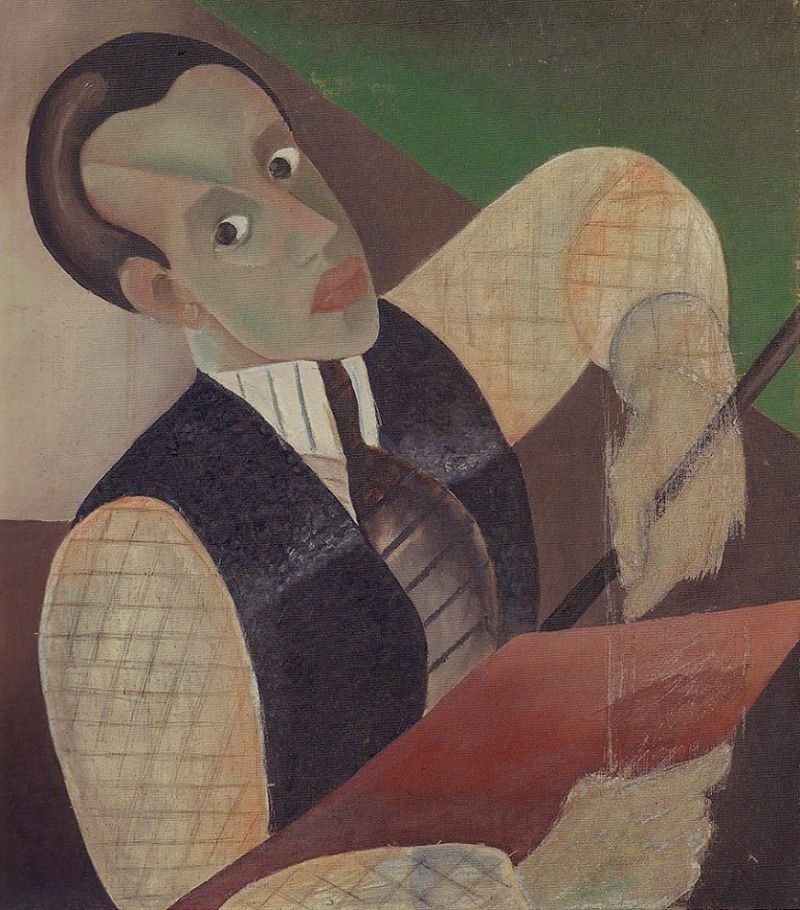Jesekiel David Kirszenbaum (1900–1954). Student of the Bauhaus





























































In October/November 1931, Kirszenbaum took part in the international exhibition in Berlin entitled Women in Need, which was held in the Haus der Juryfreien in the Platz der Republik and in which the artist showed a portrait of a lady painted in oil.[40] This was in response to a campaign against the abortion law (paragraph 218) in the women’s magazine Der Weg der Frau, which was published by the publishing group belonging to the communist publisher Willi Münzenberg (1889-1940). In 1932 and 1933, the magazine Magazin für Alle, which belonged to the Universum Bücherei für Alle book club, which had links to the KPD and was part of the International Workers’ Assistance/Internationalen Arbeiterhilfe (IAH) organised by Münzenberg, published graphic scenes by Kirszenbaum, including a community gathering in the synagogue to accompany an article by Nándor Pór entitled “God’s Law?“.[41] More of his drawings appeared in the satirical magazine Roter Pfeffer, successor to the Eulenspiegel in Münzenberg’s Neuen Deutschen Verlag, and in the Roten Fahne, the main publication of the KPD.[42]
In November 1931, on the occasion of his exhibition in the Galerie Fritz Weber, Kirszenbaum was commended in the Roten Fahne by the paper’s culture editor Alfred Durus (Alfréd Kemény,1895-1945), member of the Sturm circle and co-founder of the Asso, as “an artist of the Eastern European proletariat” (see PDF 2). Ideologically, the artist finds himself “in a transitional stage between mysticism and marxism”. The milieu of the Eastern Jewish proletariat “is suggestively and fascinatingly brought to life by him in artistically masterful oil paintings and watercolours”. “However, one hopes this ideological ascension will not be overturned like it was for the great proletariat painters of Eastern European Judaism, Chagall and Jankel Adler”. “At any rate, a hard battle still has to be fought to ensure complete coverage of the contemporary revolutionary world view, dialectic materialism”.[43]
In 1932, Kirszenbaum showed his works at the Revolutionäre Malerei exhibition, a special exhibition of the Association of Revolutionary Visual Artists/Bund revolutionärer bildender Künstler (BRBKD) now referred to as Asso.[454] The exhibition showed works of artists, and indeed of members of the BRBKD, whose work had previously been removed from the Great Berlin Art Exhibition/Großen Berliner Kunstausstellung by the police because of its critical content. In Magazin für Alle, Durus reported on Kirszenbaum’s participation in the exhibition, as well as that of Asso members Alois Erbach (1888-1972) and Horst Strempel (1904-1975) and described Kirszenbaum’s etching “Pogrom” (Fig. 11): Kirszenbaum’s scenes from Eastern European Judaism, “do not show the life of a religious community but rather the terrible fate of an Eastern proletariat that has much in common with the fate of all the word’s proletarians.”[45]
Artistically, Kirszenbaum had favoured different styles since his time at the Bauhaus. The two earliest known works, etchings with scenes from the synagogue, “Ba'ei Shalom” (those who come in peace) and a boy before the Rabbi with the Tora,[46] were presumably produced in 1923 at the Bauhaus in Weimar and still demonstrate the artist’s autodidactic, naturalistic style. The self-portrait created ca. 1925 (see cover photo) reveals a cubist influence. The voluminous and rounded forms of the upper body and the arms appear doll like and make reference to the few self-portraits by Oskar Schlemmer, the “Male Head I” from 1912.[47] Even the sharp nose, the almond eyes, the sleek hairstyle and the ears that seem to be stuck on appear to have their origins there. However, similarities with the nose and eye section in the self-portrait created by Chagall in 1914 can also be found.[48] As the head of the mural workshop at the Bauhaus, Schlemmer was obviously well known to Kirszenbaum. The “Triadic Ballet” made up of cubist figurines was performed during the Bauhaus Week at the Weimar National Theatre in August 1923, with exhibitions and publications referring to it even years later. Kirszenbaum, possibly during his time in Berlin, portrayed himself with his waistcoat, stand-up collar and tie as an attractive young man from metropolitan society and with his professional attributes, his palette and his brush.
[40] Revolution and Realism 1978 (see Literature), page 50
[41] Magazin für Alle, Volume 7, No. 4, Berlin 1932, depicted in the Revolution and Realismus exhibition catalogue 1978 (see Literature), page 130, Fig. 438, caption page 269
[42] Linsler 2013 (see Literature), page 293 f.
[43] D. (Alfred Durus): An artist of the Eastern Jewish proletariat. J.D. Kirschenbaum, in: Die Rote Fahne, No. 199, Berlin, 5 November 1931, page 10, online resource: http://zefys.staatsbibliothek-berlin.de/index.php?id=dfg-viewer&set%5Bimage%5D=10&set%5Bzoom%5D=default&set%5Bdebug%5D=0&set%5Bdouble%5D=0&set%5Bmets%5D=http%3A%2F%2Fcontent.staatsbibliothek-berlin.de%2Fzefys%2FSNP24352111-19311105-0-0-0-0.xml
[44] Revolution and Realism 1978 (see Literature), page 50
[45] Alfred Durus: Revolutionary painting. Images from Erbach, Kirschenbaum, Strempel and Wegener, in: Magazin für Alle, Volume 7, No. 8, Berlin, August 1932, page 42. The Berlin exhibition Revolution and Realism 1978 (see Literature) showed Kirszenbaum’s etching “Pogrom”, forgotten at that time, after the illustration in the essay by Alfred Durus (catalogue page 269).
[46] Both works are owned by the Leo Baeck Institute in New York, https://www.lbi.org/artcatalog/search?q=Kirszenbaum. In reality, the titles given there, “Paul von Jecheskiel”, describe the original change of ownership (i.e. presented by Jecheskiel to Paul). What is supposedly a “W” in the signature is in reality a “D”, the flourish at the top right going to the right instead of to the left. Kirszenbaum later corrected this anomaly. It can be assumed that both etchings were produced during Kirszenbaum’s early days at the Bauhaus because professional machines were to print them.
[47] Staatsgalerie Stuttgart, https://www.staatsgalerie.de/g/sammlung/sammlung-digital/einzelansicht/sgs/werk/einzelansicht/2B9BA3E84A5ADB144EECE19798B4A3CB.html
[48] Basel Museum of Art/Kunstmuseum Basel, http://sammlungonline.kunstmuseumbasel.ch/eMuseumPlus?service=ExternalInterface&module=collection&objectId=15501&viewType=detailView
























































































